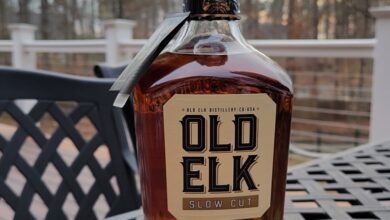Home Aging With Whiskey Sticks
By Richard Thomas

(Credit: Richard Thomas)
Growing within the larger whiskey boom are many trends relating to aging in wood. Barrel-aged cocktails are catching on in mixology, while at home a growing number of enthusiasts have taken to experimenting with further aging off-the-shelf whiskey using small barrels and so-called “whiskey sticks.”
The basic principle behind the whiskey sticks isn’t a new one, and has been at work in the wine industry for decades, where putting wine and oak chips into a stainless steel tank has been a recognized and cheap alternative to oak barrels (albeit not one used with better wines). For my part, when whiskey sticks began appearing I became curious about adding them to spice and fruit infusions and home re-blending as an option for what to do with a disappointing bottle.
Choice Of Sticks
Instead of going with the most hyped of the whiskey sticks, Whiskey Elements, I used the Aging Masts of Beyond Barrels. Compared to Whiskey Elements, Aging Masts are essentially stout wooden dowels. This makes them thicker, so in theory there is more wood to draw on, but also means they lack the surface cuttings of Whiskey Elements, which increase the surface area and speed up the absorption of chemicals from the oak. This makes Aging Masts a choice for those in for the long haul, because where Whiskey Elements claim results in as little as 24 hours, Beyond Barrels bills their whiskey sticks as taking up to a month.
Two Experiments
I experimented with two whiskeys, Clarke’s Bourbon and Passport Scotch, and I think this pair revealed both the potential and limitations of whiskey sticks. I had given Clarke’s a poor grade, citing a thin character that afflicted both its flavor and its texture. To this day I have doubts as to whether Clarke’s is actually real bourbon by American standards, since as a European supermarket brand it might be more like Early Times, and aged in spent barrels.

(Credit: Richard Thomas)
On Clarke’s I used a cherry mast, and after more than three weeks in the bottle that wood had a discernible impact on the whiskey, which became sweeter and fruitier. However, the thin character remained, so much so that the fruity flavors were also thin, like new writing put down on tissue paper. This outcome reveals that whiskey sticks might add flavor, but they cannot improve on cheap cuts of spirit made at the stillhouse.
Despite being essentially a downmarket version of Chivas Regal, Passport was already a full letter grade better than Clarke’s. I expected more from it, and after two and a half weeks I wasn’t disappointed. Here the same fruity character imparted by the wood enhanced the honeyed sweetness already in the flavor profile, sublimating the Scotch’s astringency. In other words, it gave the Scotch what it needed to come into better balance.
Ultimately, sticks were a poor choice for trying to do something with Clarke’s. With something like that, the only viable option is to do a heavy infusion, or else put it in the kitchen with the cooking sherry.
Passport, however, had a good base to work with, and the modest nudge given to it by the stick-aging gave the flavor profile better balance. Whiskey sticks won’t remake your whiskey, but they can add a little something extra to it, and sooner or later every whiskey enthusiast ends up with something on the shelf that needs a little something extra.



This is what I like. When I read about these things, they look like ads for Whiskey Elements. You are like “sometimes they work a little, sometimes they don’t at all,” and you used something other than the flavor of the month. Good calls.
That is because most of the things you see ARE paid adds for Whiskey Elements 🙂